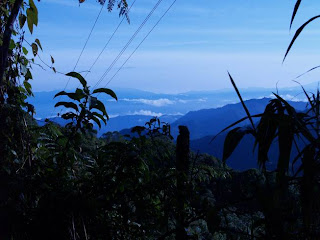
Day one started with a tour around Quito, including a trip up a cable car to the crater of nearby volcano (quiet for now) which gave some impressive views of the city, although stair climbing at 4100m (13,300 ft) above sealevel was a challenge.

This is Jorge with our wheels for the trip (yes, I know I said it was a Blazer - it is a Rodeo). The main roads aren't bad although the driving is pretty freeform; double yellow lines are more of a guideline than a rule. The last dozen kilometres to Bellavista Cloud Forest Lodge were along a single track dirt road with wash aways that could eat a Smart car. At one point we had to reverse about 200m to allow another vehicle to pass.
 The lodge is located in the midst of the forest and is run by an Englishman who arrived with a back pack in 1982 and never left. All the buildings are of local materials. There are a number of very knowledgeable guides who take you for walks in the forest at dawn, mid morning and late afternoon. Rubber boots (which we did bring) are a must, although they will provide them if you have no objections the sharing other people's foot sweat. Some of the trails are incredibly steep and on the late afternoon walk (also at 2800m) I felt like I do at the end of fast (for me) 10 km run.
The lodge is located in the midst of the forest and is run by an Englishman who arrived with a back pack in 1982 and never left. All the buildings are of local materials. There are a number of very knowledgeable guides who take you for walks in the forest at dawn, mid morning and late afternoon. Rubber boots (which we did bring) are a must, although they will provide them if you have no objections the sharing other people's foot sweat. Some of the trails are incredibly steep and on the late afternoon walk (also at 2800m) I felt like I do at the end of fast (for me) 10 km run.
 Why it got its' name. The cloud doesn't so much as blow in, but actually materializes over the forest - could be something in this for the biologists that are arguing that biological agents seed clouds and cause rain and snow (see New Scientist - this month).
Why it got its' name. The cloud doesn't so much as blow in, but actually materializes over the forest - could be something in this for the biologists that are arguing that biological agents seed clouds and cause rain and snow (see New Scientist - this month).
 The balcony or our room - made of local bamboo like material, alhough the larger canes come from lower down the mountains on the coastal side. It does keep the rain off but has no sound insulating properties - with 3 units in the building, you had to hope no-one wanted to stay up late.
The balcony or our room - made of local bamboo like material, alhough the larger canes come from lower down the mountains on the coastal side. It does keep the rain off but has no sound insulating properties - with 3 units in the building, you had to hope no-one wanted to stay up late.

I admit it - I have lots of bird photos, but I am going to behave and not clutter the blog with them; I thought I would show off a bit with this one of a racquet-tail humming bird in flight. There were dozens of hummingbirds of several species hovering around the lodge at all times in daylight.

Ditto for flowers!























